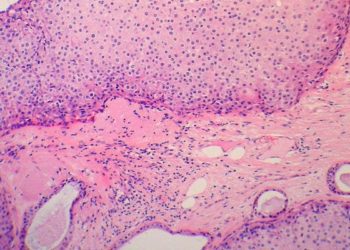Screening with digital breast tomosynthesis vs mammography associated with significantly lower risk of advanced breast cancer among women with extremely dense breasts at high risk of breast cancer
1. Compared to mammography, screening with digital breast tomosynthesis was not associated with a significant difference in risk of interval invasive cancer and associated with a significantly lower risk of advanced breast cancer among women with extremely dense breasts at high risk of breast cancer.
2. No significant difference was observed in women with nondense breasts, heterogeneously dense breasts, or with extremely dense breasts not at high risk.
Evidence Rating Level: 2 (Good)
Study Rundown: Digital breast tomosynthesis (DBT) is a breast imaging modality commonly used in women with dense breasts to help improve cancer detection. Due to a lack of current data, this cohort study evaluated whether DBT vs digital mammography is associated with a lower risk of interval invasive cancer, advanced breast cancer, and false positives among women undergoing routine screening by extent of breast density and breast cancer risk. Key outcomes included rates of interval invasive cancer within 12 months of screening mammography and advanced breast cancer within 12 months of screening mammography. Among 504 427 women screened, interval cancer rates were not significantly different for DBT vs digital mammography. However, in a subset of women with extremely dense breasts and high risk of breast cancer, advanced cancer rates for DBT vs digital mammography were 0.27 vs 0.80 per 1000 examinations, respectively (statistically significant). Among women with nondense breasts, heterogeneously dense breasts, or extremely dense breasts with low to average risk of breast cancer, no significant differences in advanced cancer rates were observed. A limitation of this study was ensuring that risk factors and demographics were comparable for both imaging groups for accurate outcomes assessment.
Click to read the study in JAMA
Click to read an accompanying editorial in JAMA
Relevant Reading: Effectiveness of digital breast tomosynthesis compared with digital mammography: outcomes analysis from 3 years of breast cancer screening
In-Depth [prospective cohort]: This cohort study included 504 427 women (median age [IQR], 58 [50-65] years) undergoing screening digital mammography and DBT examinations from 2011-2018 at 44 US Breast Cancer Surveillance Consortium (BCSC) facilities with follow-up through 2019. Overall, interval invasive cancer rates per 1000 examinations were not significantly different for DBT (0.57) vs digital mammography (0.61) (difference, −0.04; 95%CI, −0.14 to 0.06; P = .43) or among patients with low to average risk or high risk across breast density categories. Compared to digital mammography, advanced cancer rates per 1000 examinations were significantly lower for DBT for women with extremely dense breasts at high risk of breast cancer (0.27 vs 0.80; difference, −0.53; 95%CI, −0.97 to −0.10), but not for women at low to average risk (0.54 vs 0.42; difference, 0.12; 95%CI, −0.09 to 0.32).
Image: PD
©2022 2 Minute Medicine, Inc. All rights reserved. No works may be reproduced without expressed written consent from 2 Minute Medicine, Inc. Inquire about licensing here. No article should be construed as medical advice and is not intended as such by the authors or by 2 Minute Medicine, Inc.







